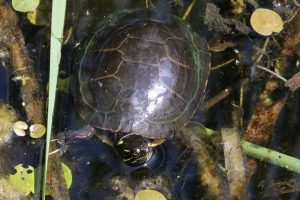by Monica Seidel, Digital Communications and Marketing Intern
Growing up, many of us would have welcomed the idea of sleeping in and missing school. Perhaps there was an early morning class or teacher you were not fond of, or you had to trek through the cold to get to school. If someone had offered you the option to simply sleep through half of the year, bypassing the cold and school year, would you have done it? How would you have been able to survive sleeping that long?
While they are not worried about skipping school, Canada’s turtle species have to resort to extreme measures to survive our cold, cold winters. Turtles are cold-blooded animals which means they need an external source of heat to control their body temperature. Many turtle species sit out in the sun on a log or rock to warm up, called basking. When they are cold, they become slow and sluggish, making them more susceptible to predation, being hurt on roadsides, and slower in finding a hibernation site, nesting area, or mate.
To survive Canada’s cold, long, and dark winters, turtles use a technique called hibernation. In late fall, turtles will dig down to the bottom of certain water bodies and enter an induced sleep underneath the soil until springtime. To survive the winter, turtles must have enough food stored up to survive all those months, but also have enough energy to emerge in spring and find themselves some food. Cold temperatures at the bottom of water bodies mean turtles will slowly use up their food supplies.
Turtle species may hatch from their egg in the fall, meaning they have to find a suitable hibernation site quickly. If these “fall hatching” eggs do not hatch before winter, there is a very low chance of survival as the eggs will freeze. Some species, however, have adapted to hatching the following spring. These species, like the midland painted turtle (Chrysemys picta marginata; pictured below), can survive the winter because of a large yolk sac. Species that stay in the egg through the winter may have additional benefits, such as avoiding predation in the fall, avoiding the risk of an early winter or early freeze, and emerging from their egg in the spring when there is ideal weather conditions and plenty of food available.

Turtles are amazing creatures who have adapted to a country known for its extreme weather. They are so smart that they have figured out how to live through tough Canadian winters without having to directly deal with the ice, snow, short hours of sunlight, and cold temperatures – perhaps they do not need school after all!
You can support Canada’s turtles by symbolically adopting a painted turtle or a Blanding’s turtle! Each symbolic adoption is eligible for a Canadian tax receipt, and comes with a 5″x7″ postcard featuring artwork by a Canadian artist.
___
Turtles are beginning to find hibernation sites this time of year, so it is important to know how you can help turtles have the best chance at survival. If you see a turtle crossing the road, you can help it in the way it is walking if it is safe for you to do so. This is a great video showing how to help a snapping turtle (Chelydra serpentine) cross the road, as special consideration must be made for their large size and risk of snapping. For all other turtle species, you can safely handle them by firmly grabbing them with both hands in the middle of their shell like a sandwich. Make sure to wash your hands after handling a turtle, as all species in Ontario naturally carry salmonella, which can be passed to humans. If you notice an injured turtle, contact the Ontario Turtle Conservation Centre (705-741-5000) or a local wildlife rehabilitation centre for instructions to help and transport the turtle.

At what external temperature do snapping turtles stop hibernating and ‘wake up’?